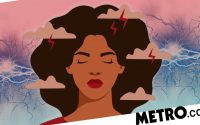Women exposed to a chemical in soap ‘more likely to break bones’
Women exposed to a ‘gender-bending’ chemical found in some anti-bacterial soaps and toothpastes ‘are more likely to break their bones’
- Triclosan is used in products such as toothpaste, mouthwash and cosmetics
- A study found women with higher levels in the urine had weaker bones
- Researchers said triclosan could be a risk for the bone disease osteoporosis
Women exposed to a chemical found in some anti-bacterial soaps are more likely to break their bones, a study suggests.
The gender-bending chemical triclosan could be a risk factor for the bone disease osteoporosis, researchers said.
Triclosan, used in some toothpastes, soaps, mouthwashes, and some cosmetics, has previously been linked to bowel cancer and antibiotic resistance.
It has already been banned in some products in the US, such as over-the-counter hand sanitisers. But no such ban exists in the UK.

Women exposed to a chemical found in some anti-bacterial soaps are more likely to break their bones, a study of women in the US suggests
Chinese scientists analysed data from 1,848 women in the National Health and Nutrition Examination Survey.
Those with higher levels of triclosan in their urine were more likely to have bone issues, it was discovered.
An author of the study, Yingjun Li, from Hangzhou Medical College School of Public Health in Hangzhou, China, said: ‘Laboratory studies have demonstrated that triclosan may have potential to adversely affect the bone mineral density in cell lines or in animals.
‘However, little is known about the relationship between triclosan and human bone health.
‘As far as we know, this is the first epidemiological study to investigate the association between triclosan exposure with bone mineral density and osteoporosis in a nationally representative sample from US adult women.’
WHAT IS TRICLOSAN?
Triclosan, a chemical added to personal-care products to prevent bacterial contamination, has been linked to poor heart health and an underactive thyroid.
It is added to antibacterial soaps, body washes, toothpastes and cosmetics, as well as some clothing, furniture and toys.
Triclosan also stops infections responding to antibiotics, which may contribute towards the resistance crisis.
The chemical was banned in soaps in the US in 2016. No such ban exists in the UK.
The FDA declared antibacterial soaps containing triclosan are no more effective than hot water and regular cleansers at killing bugs.
The results were published in the Journal of Clinical Endocrinology and Metabolism.
In the US, the Food and Drug Administration (FDA) banned triclosan from antiseptic and antibacterial hand rubs and hand washes in 2016. It declared the chemical was no more effective at killing bugs than hot water and regular cleansers.
Regulators in the UK did not follow suit, however its use is being phased out gradually in Europe.
Unilever is one manufacturer that has phased out triclosan from its entire range of products in response to consumer demand, although it says it is confident the chemical is safe.
As well as personal care products, traces of triclosan – an anti-bacterial agent – can also be found in clothing, kitchenware, furniture and toys.
It is considered to be an endocrine-disruptor, a group of chemicals often referred to as gender-bending because they are thought to alter the bodies’ hormones by mimicking or blocking them.
When people use a product containing triclosan, they can absorb a small amount through their skin or mouth.
A 2008 study by the US Centers for Disease Control and Prevention found triclosan in the urine of nearly 75 percent of those tested.
They stated that some animal studies have shown that exposure to high doses of triclosan may decrease levels of some thyroid hormones.
WHAT IS OSTEOPOROSIS?
Osteoporosis is a condition that weakens bones, making them fragile and more likely to break.
It develops slowly over several years and is often only diagnosed when a minor fall or sudden impact causes a bone fracture.
The most common injuries in people with osteoporosis are wrist, hip and spinal bone fractures.
However, they can also occur in other bones, such as in the arm or pelvis.
Sometimes a cough or sneeze can cause a rib fracture or the partial collapse of one of the bones of the spine.
Osteoporosis isn’t usually painful until a fracture occurs, but spinal fractures are a common cause of long-term pain.
Figures suggest 54million people have the condition in the US, while 3million are thought to suffer in the UK.
Source: NHS Choices
Source: Read Full Article


